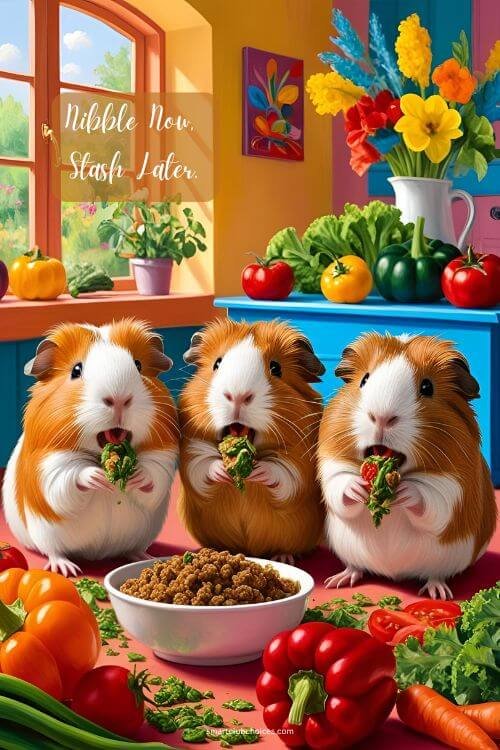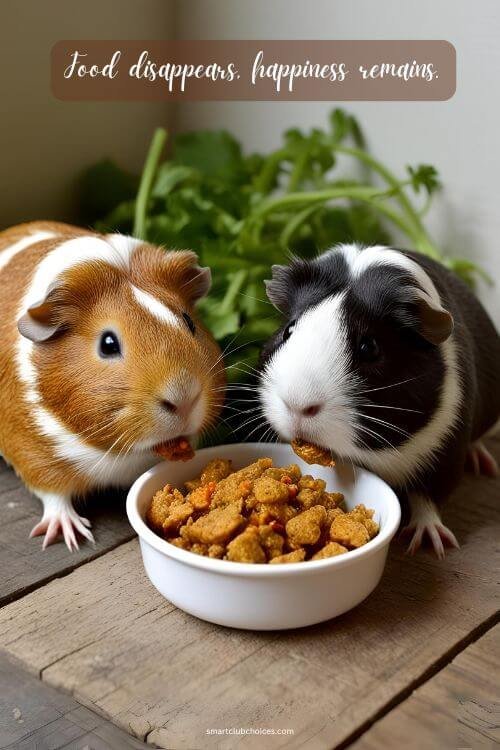Guinea Pig Diet : What to Feed and What to Avoid
A Well-Fed Piggy is a Happy Piggy
Welcome to the ultimate guide to feeding your guinea pig! If you’ve ever wondered why your little furball is staring at you like you’re holding the last carrot on Earth, this blog is for you.
Guinea pigs are adorable, chatty, and surprisingly picky eaters. But don’t worry—we’ve got you covered. From the good stuff to the no-no’s, let’s dive into the world of guinea pig nutrition.
Table of Contents
(1) The Basics of a Guinea Pig’s Diet
Guinea pigs are herbivores, which means they’re all about that plant life. No meat, no dairy, just fresh greens, hay, and the occasional treat. But here’s the kicker: their digestive systems are like tiny, sensitive factories. If you feed them the wrong thing, it’s like throwing a wrench into the gears.
The three pillars of a guinea pig’s diet are:
- Hay: This is the bread and butter (or should we say grass and greens?) of their diet. It keeps their teeth healthy and their digestion running smoothly.
- Fresh Vegetables: These provide essential vitamins, especially Vitamin C, which guinea pigs can’t produce on their own.
- Pellets: High-quality guinea pig pellets are like their daily multivitamin, ensuring they get all the nutrients they need.

(2) Hay—The MVP of Guinea Pig Diets
If guinea pigs could write love letters, they’d probably write them to hay. Hay is non-negotiable. It’s like the Wi-Fi of their world—they can’t live without it.
Why Hay?
- Dental Health: Guinea pigs’ teeth never stop growing, and chewing hay helps wear them down.
- Digestion: Hay keeps their gut moving, preventing blockages and other digestive issues.
- Entertainment: Let’s be honest, munching on hay is basically their version of binge-watching Netflix.
Types of Hay
- Timothy Hay: The gold standard for adult guinea pigs. It’s high in fiber and low in calories.
- Orchard Grass: A good alternative if your guinea pig is picky about Timothy hay.
- Alfalfa Hay: This is like the dessert of hays—high in calcium and protein. It’s great for young, growing guinea pigs or pregnant moms but should be avoided for adult pigs to prevent bladder stones.
Pro tip: Always make sure your guinea pig has unlimited access to fresh hay. If they run out, they’ll let you know—loudly.
(3) Fresh Vegetables—The Colorful Side of Life
Guinea pigs love their veggies, and who can blame them? Fresh vegetables are like a daily treasure hunt for them. But not all veggies are created equal. Here’s what to feed and what to avoid.
The Good Stuff
- Leafy Greens: Romaine lettuce, kale, spinach, and cilantro are all great options. These are packed with Vitamin C, which is crucial for your piggy’s health.
- Bell Peppers: These are like Vitamin C bombs. Plus, they come in fun colors!
- Carrots: A classic favorite, but feed in moderation because they’re high in sugar.
- Cucumbers: Hydrating and refreshing, especially on hot days.
The Not-So-Good Stuff
- Iceberg Lettuce: It’s basically crunchy water with no nutritional value and can cause diarrhea.
- Potatoes: Starchy and hard to digest. Just say no.
- Onions and Garlic: These are toxic to guinea pigs and can cause serious health issues.
Remember: Introduce new veggies slowly to avoid upsetting their stomachs. And always wash them thoroughly to remove pesticides.
(4) Pellets—The Nutritional Safety Net
Pellets are like the insurance policy of your guinea pig’s diet. They ensure your piggy gets all the nutrients they need, even if they’re being picky with their veggies.
Choosing the Right Pellets
- Look for Vitamin C: Guinea pigs can’t store Vitamin C, so their pellets should be fortified with it.
- Avoid Fancy Mixes: Pellets with seeds, nuts, or colorful bits might look fun, but they’re often unhealthy and can be a choking hazard.
- Check the Expiry Date: Vitamin C degrades over time, so fresh pellets are a must.
How Much to Feed
Adult guinea pigs need about 1/8 to 1/4 cup of pellets per day. Overfeeding can lead to obesity, so stick to the recommended amount.
(5) Treats and No-Nos
Let’s talk about treats—the fun part of any diet! But before you start spoiling your guinea pig, there are a few things to keep in mind.
Safe Treats
- Fruits: Apples, strawberries, and blueberries are great in small amounts. Remember, fruits are high in sugar, so moderation is key.
- Herbs: Parsley, basil, and mint are tasty and safe options.
Dangerous Foods
- Chocolate: Toxic to guinea pigs (and yes, they’ll try to eat it if given the chance).
- Dairy: Guinea pigs are lactose intolerant. No cheese, no milk, no yogurt.
- Processed Foods: Chips, bread, and crackers are a big no. Stick to natural, fresh foods.

(6) Conclusion: Happy Guinea Pig, Happy Life
Feeding your guinea pig doesn’t have to be complicated. Stick to the basics—hay, fresh veggies, and high-quality pellets—and you’ll have a happy, healthy piggy on your hands. Treats are fine in moderation, but always avoid the no-nos.
Remember, every guinea pig is unique. Some might go crazy for bell peppers, while others might turn their noses up at them. Pay attention to their preferences and adjust their diet accordingly.
And finally, don’t forget to enjoy the process. Watching your guinea pig munch on their favorite foods is one of life’s simple joys. So go ahead, hand them that carrot, and bask in the glory of being the best guinea pig parent ever. Now, if you’ll excuse me, my guinea pig is giving me the “where’s my snack?” look. Until next time, happy feeding!








